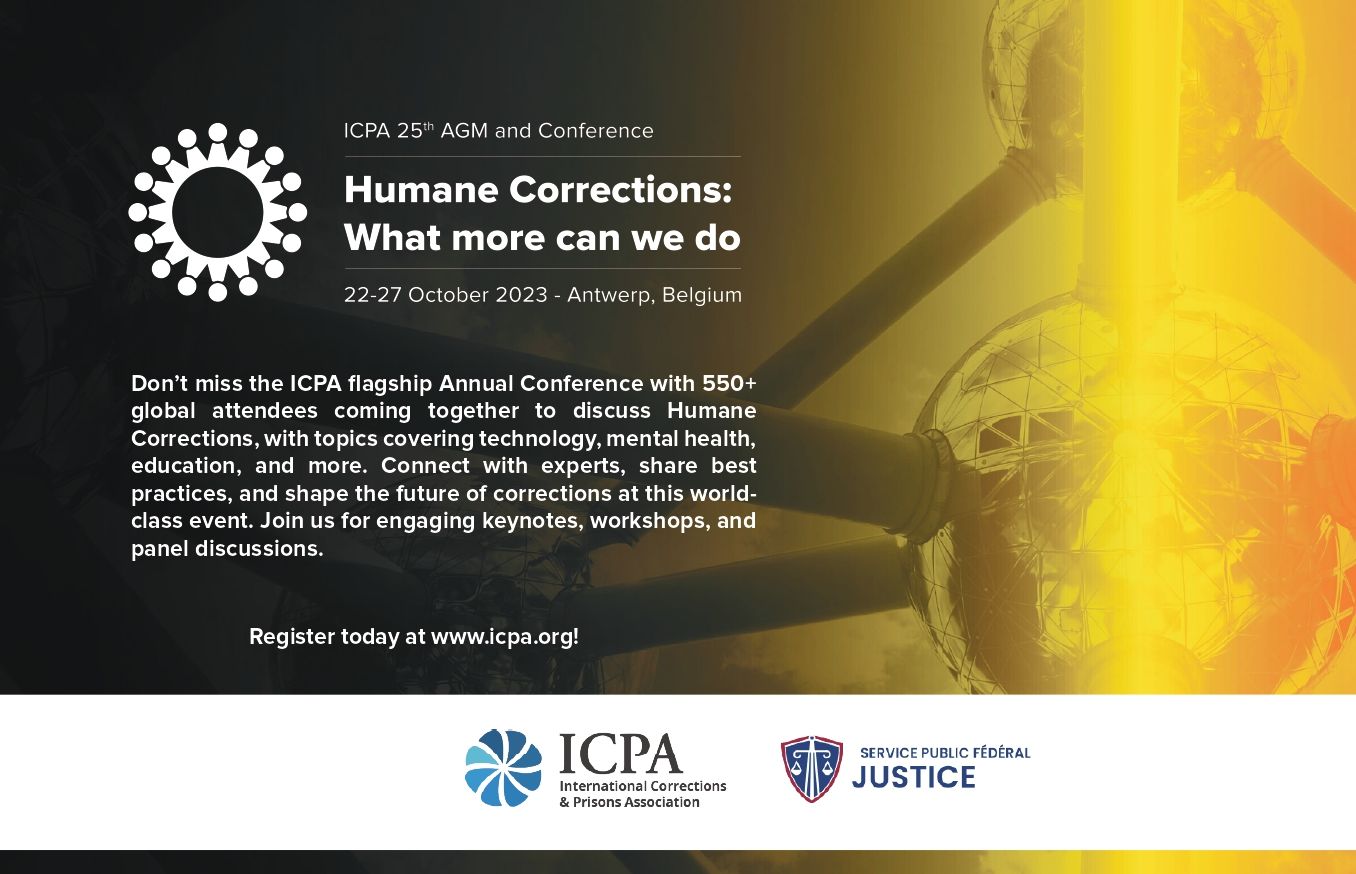Interview
Simon Bonk
Chair of the Technology Solutions Network, Internacional Corrections and Prisons Association
What are the main goals of the ICPA Technology Solutions Network?
SB: One of the key goals of the Technology Solutions Network is to bring people together, to share their experiences concerning the implementation of technology solutions, as well as digital strategy development practices across jurisdictions. This allows us to create a community of sharing, engagement, and networking.
And the community is not limited to technologists. It is important to consider the broad impact of technology. To do this we strive to be inclusive and bring in different voices such as researchers from academia, nonprofits, as well as jurisdictional decision-makers. We work with these different stakeholders to promote research and evaluation of practices rounding out the conversation.
We also try to challenge vendor partners to think differently about technology and to adapt their solutions to the problems that the corrections sector is facing.
We believe building a community is essential. Within the correctional space, every sector is very siloed. The practitioners stay in one silo, the technologists, even within a jurisdiction, stay in their silo, and the same with the vendors. We’re working to break that down.
As a global organisation, we focus on the global opportunity of technology and of improving correctional services’ efficiency and effectiveness.
What are the Technology Solutions Network’s main priorities at the moment?
SB: At the latest ICPA Annual Conference, in October 2022, we brought the technology network together face to face, it was one of the most well-attended meetings that we have ever had. We filled the room with close to 60 vendor partners, academic researchers, and jurisdictional representatives from every corner of the world.
During our discussion, we talked about where we should be focusing our efforts to be more impactful. That led to a really good conversation about some of the challenges that we are facing. We are narrowing them down and developing sub-working groups to tackle some of those challenges.
Coming out of that meeting one of the key priorities we heard was the adaptation and implementation of emerging technology that can change the landscape of corrections, such as virtual reality, artificial intelligence, blockchain, and cloud computing.
It is important to think about how we can leverage these emerging technologies and apply them in the sector. We must also consider the risks associated with their implementation.
For example, there are concerns about bias in artificial intelligence. Some colleagues in our network are working with the Council of Europe to create recommendations that will help to mitigate these risks.
Another priority is digital inclusion. This applies not just to inmates, but also to correctional officers, staff, and other stakeholders.
When we talk about the notion of "normalcy", it should entail bringing technology into the prison environment, so that the incarcerated individuals can experience what the reality is going to be when they leave.
This is also important when considering how new generations of individuals coming into our prisons are increasingly tech-savvy.
How do we sustain that appreciation for technology within the institutions? Can we have institutional technology reflect the technological progress in society in general?
Globally, jurisdictions are facing recruitment and retention challenges. As a collective can we explore the need for modernisation to improve staff training and wellness? We will consider whether there are tangible actions via technology that can strengthen our posture and facilitate improvements to make corrections a more attractive place to work.
The group acknowledged that the procurement process is noteworthy for both jurisdictional representatives and vendors. It is all about being able to procure solutions in an agile manner.
Having now been on both sides of the fence, as the CIO of the Correctional Service of Canada, and now in the private sector, I can tell you it is painful for both sides.

Governments and citizens need solutions quickly, and the procurement processes within governments are outdated. So, we have an opportunity here to come together to influence this, whether by trying to initiate the modernisation of procurement, developing best practices, or creating standard Request for Proposals (RFPs), for example.
Another topic that received much attention was around promoting the business case to advance modernisation. Our sector usually does not do a good job of presenting the benefits and return on investment of digital transformation. We must cooperate to develop research that empirically links correctional outputs to societal gains.
We talk about recidivism and rehabilitation, and these are incredibly important goals for correctional jurisdictions. But our political decisionmakers are more focused on other issues, such as strengthening the economy, dealing with racial equality, or indigenous reconciliation.
Correctional services are competing for investment against other departments presenting strong business cases. If you invest in more efficient tax administration, you’re generating more money for the fiscal framework, which then provides benefits; if you look at border security, they also facilitate the economy. Those are very compelling outcomes for politicians.
Corrections needs to do a better job in presenting, for example, how recidivism impacts those greater societal gains, strengthening the business case that will enable treasury departments to invest in modernisation.
Our group discussed coming together to develop a common narrative with empirical research to support the links between correctional outputs and societal outcomes allowing for a stronger case for modernisation and facilitating the success of transformation.
What major challenges and opportunities do you identify in terms
of technology solutions and digital transformation in Corrections?
SB: I’m not sure that the biggest challenges and opportunities are necessarily linked to the use of technology in Corrections.
I’m not saying implementation is easy, but it is probably a lesser component of the challenges and opportunities that come with the digital transformation of corrections. I believe that solutions can be imported from other sectors, such as smart cities and the health industry, and then modified to fit the needs of corrections.
The technology exists, it’s the opportunity/problem identification coupled with the measured implementation and change management approaches that are the bigger challenge. Only about a third of digital transformation efforts are actually successful, because of a lack of effective change management.
The ability of jurisdictions to make space to modernise and improve their operations through a strategic lens that maximises the opportunity is where we need to focus.
The reality is that if we want to move forward and improve corrections there needs to be a coordinated effort with a clear strategy and vision.
While there have been some efforts made in the past, they have been disparate and not well coordinated. There are a lot of great one-off initiatives, but they lack coordination and can result in efforts running at cross purposes. In my opinion, another challenge lies in the ability of technologists to influence their business partners, within their jurisdictions, to think differently and inspire change. And then work as a catalyst to implement it in a strategic way.
How can the ICPA Technology Solutions Network support the development and successful roll-out of technology in the sector?
SB: Every jurisdiction has different needs, but a lot of them are common. We have to work globally with different jurisdictions and different partners to try to advance corrections through the use of technology.
We are setting up working groups to tackle three priorities which we are in the process of identifying.
The goal is to come together and plan a way forward, for each, that can make a measurable difference. As an example of something we could pursue, we could partner with other associations to work towards developing standards that will benefit vendors and jurisdictions alike.
The American Probation and Parole Association (APPA) has already started down this road, and hopefully, ICPA can contribute to that. Alternatively, we may consider other ways to contribute to this opportunity, but it remains to be seen where the group will focus its efforts.
In general, I would say that the strength of what our group can accomplish, comes from sharing knowledge. There is an old saying, “knowledge is power”, but I actually believe that our group has evolved beyond this outdated sentiment to “sharing knowledge is power”. I believe our group holds this as a core value.
We can share best practices and work to develop a tangible contribution to our sector. That could take the form of establishing a better business case for modernisation that will facilitate greater investment for jurisdictions. Or coming together as a community to share our collective intellectual property on emerging technology to better inform our sector of the potential for applying these technologies in the correctional space.
If the jurisdictions, academia, and vendors come together, everybody benefits. It is essential that we join forces and share our knowledge and expertise.
How can professionals and organisations get involved in the Technology Solutions Network and cooperate?
SB: The Network is primarily composed of members of the International Correction and Prisons Association (ICPA).
I strongly encourage interested parts to sign up and be a member of ICPA, which brings its own benefits.
We are always looking to recruit jurisdictional leaders, and we have had some success in increasing the number of decision-makers involved in the network. Our board liaison Steven Van De Steene has been invaluable in promoting our group and a big thank you for all of his efforts.
There has always been interest from the vendor community and a growing participation from academia and non-profits.
However, it would also be great to have more business leaders from the involved jurisdictions as well. The integration between technology and business is crucial, because technology isn’t the solution, but rather, it can facilitate or perhaps inspire solutions. It would be great to build relationships with business leaders in corrections and this is something we will continue to focus on in the future.
Simon Bonk
Chair of the Technology Solutions Network, ICPA
Simon Bonk is a member of ICPA’s Technology Solutions Network since 2016 and has been Chairing the group since 2018. He is also a member of the Corrections Technology Association Board and Chief Research Officer and Director of New Business Development at Telio Group. Bonk was, for more than six years, the CIO and Director General of Information Management for the Correctional Service of Canada.



